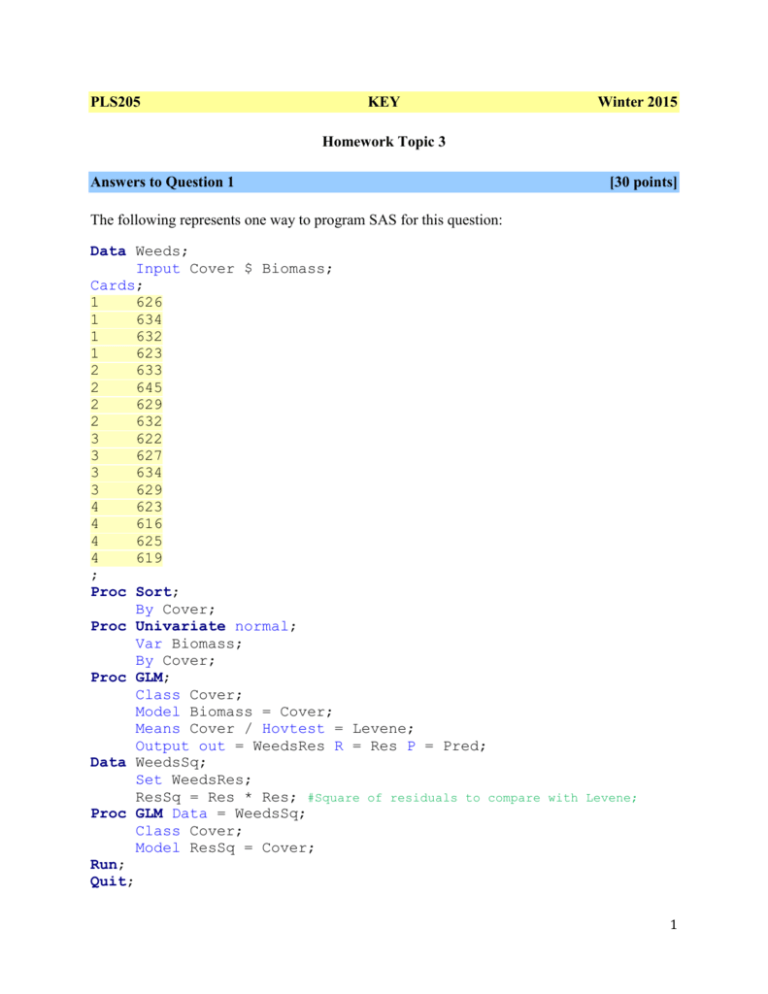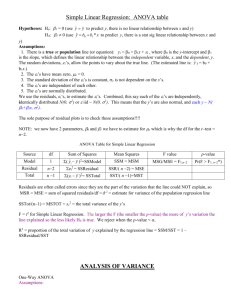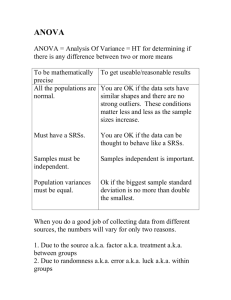3.1 From these values, calculate MST, MSE, the F
advertisement

PLS205 KEY Winter 2015 Homework Topic 3 Answers to Question 1 [30 points] The following represents one way to program SAS for this question: Data Weeds; Input Cover $ Biomass; Cards; 1 626 1 634 1 632 1 623 2 633 2 645 2 629 2 632 3 622 3 627 3 634 3 629 4 623 4 616 4 625 4 619 ; Proc Sort; By Cover; Proc Univariate normal; Var Biomass; By Cover; Proc GLM; Class Cover; Model Biomass = Cover; Means Cover / Hovtest = Levene; Output out = WeedsRes R = Res P = Pred; Data WeedsSq; Set WeedsRes; ResSq = Res * Res; #Square of residuals to compare with Levene; Proc GLM Data = WeedsSq; Class Cover; Model ResSq = Cover; Run; Quit; 1 1.1 test. Test the normality of the observations within each treatment using the Shapiro-Wilk [4 points] 1.1 The Shapiro-Wilk results with the ‘Normal’ option in Proc Univariate: Cover Crop --W Statistic---p Value-Vetch 0.930008 0.5944 Oats 0.837666 0.1887 Oats + Vetch 0.994780 0.9805 Tillage Radish 0.962716 0.7960 Since the Shaprio-Wilk p-value > 0.05 for all four treatments, we fail to reject H0, and we accept our assumption that the data are normal with 95% confidence. 1.2 Is there a significant difference among the cover crops? What is the probability this ‘difference’ is really just the result of the random sampling from a population with no differences among cover crops? [10 points] 1.2 The results of the one-way ANOVA performed using Proc GLM on the biomass variable: Source DF Sum of Squares Mean Square F Value Pr > F Model 3 394.6875000 131.5625000 Error 12 350.2500000 29.1875000 Corrected Total 15 744.9375000 4.51 0.0245 R-Square Coeff Var Root MSE Biomass Mean 0.529826 0.860192 5.402546 628.0625 Since the calculated F-value of 4.51 is greater than the critical F-value of 3.49 (refer to the Ftable), we reject H0. There are significant differences among the means. The probability that the observed difference is merely the result of random sampling from a single population is given by the p-value: 0.0245 of the ANOVA. This is less than our chosen significance level of 0.05; thus, the differences are ‘significant.’ The R-Square value indicates that our model explains 52.9% of the variation in weed biomass in this experiment. 1.3 Calculate the residuals of each observation by hand or using Excel. [4 points] 2 The following table presents the treatment means, residuals (Residuals = Yij – Yj), and squared residuals: Cover Crop Biomass Vetch Vetch Vetch Vetch Oats Oats Oats Oats Oats + Vetch Oats + Vetch Oats + Vetch Oats + Vetch Tillage Radish Tillage Radish Tillage Radish Tillage Radish 626 634 632 623 633 645 629 632 622 627 634 629 623 616 625 619 Treatment Residuals Average -2.8 5.2 628.8 3.2 -5.8 -1.8 10.2 634.8 -5.8 -2.8 -6.0 -1.0 628 6.0 1.0 2.2 -4.8 620.8 4.2 -1.8 Residuals^2 7.84 27.04 10.24 33.64 3.24 104.04 33.64 7.84 36.00 1.00 36.00 1.00 4.84 23.04 17.64 3.24 1.4 Use SAS to perform an ANOVA of the squared residual values. Compare the result of this ANOVA with the result of the Levene option in the ‘Means’ statement for Proc GLM. Are the variances homogeneous among cover crops? How does the result of Levene’s test compare with the ANOVA of the squared residuals? [10 points] 1.4 The results of the one-way ANOVA on the squared residuals: Source DF Sum of Squares Mean Square F Value Pr > F Model 3 1377.98047 459.32682 Error 12 8638.56250 719.88021 Corrected Total 15 10016.54297 0.64 0.6048 And the results of Levene’s test from the original Proc GLM for the biomass variable: Levene's Test for Homogeneity of Biomass Variance ANOVA of Squared Deviations from Group Means Source DF Sum of Squares Mean Square F Value Pr > F Cover 3 1378.0 459.3 0.64 0.6048 3 Levene's Test for Homogeneity of Biomass Variance ANOVA of Squared Deviations from Group Means Source DF Sum of Squares Mean Square F Value Pr > F Error 12 8638.6 719.9 The results of the two procedures are identical (F = 0.64, p = 0.06048). With p-values > 0.05, we fail to reject the H0. At our chosen significance level of 95%, the variances among the treatments are accepted as homogeneous. 1.5 Present a box plot of the data. [2 points] 4 Answers to Question 2 [15 points] Just this once in this course, we are going to ask you to do an ANOVA by hand or Excel and the definition formulas for sum of squares treatment (SST) and total sum of squares (TSS). You can calculate the error sum of squares SSE as a difference. Use the data from Question 1, take a deep breath, and go to it. Show all calculations (the columns with the intermediate calculations. The results of your ANOVA-by-hand should be frighteningly similar to those generated by SAS in Question 1. A quick run-down of the formulas you should have used: Source df SS MS F Treatment t-1=4-1=3 SST =394.7 SST/dfTrt = 131.6 Error t(r-1)=4*3=12 TSS – SST = 350.3 SSE/dfErr = 29.2 MST/MSE=4.51 P Table F3,12 Total rt-1=16-1=15 TSS =744.9 TSS/dfTot = 49.7 where r = the number of replications per treatment (4) and t = the number of treatments (4). Calculations from Excel values below: TSS = 744.9 SST = 394.7 SSE = TSS – SST = 744.9 – 394.7 = 350.3 Excel calculations: Overall mean = 628.1 1 1 1 1 2 2 2 2 3 3 3 3 4 4 4 4 626 634 632 623 633 645 629 632 622 627 634 629 623 616 625 619 (𝑌𝑖𝑗 − 𝑌̅.. ) -2.1 5.9 3.9 -5.1 4.9 16.9 0.9 3.9 -6.1 -1.1 5.9 0.9 -5.1 -12.1 -3.1 -9.1 (𝑌𝑖𝑗 − 𝑌̅.. )2 4.3 35.3 15.5 25.6 24.4 286.9 0.9 15.5 36.8 1.1 35.3 0.9 25.6 145.5 9.4 82.1 TSS = 744.9 5 1 2 3 4 (𝑌̅𝑖. − 𝑌̅.. ) 0.7 6.7 -0.1 -7.3 (𝑌̅𝑖. − 𝑌̅.. )2 0.5 44.7 0.0 53.5 SS = 98.7 SST = r *SS = 394.7 SSE = TSS – SST = 350.3 Trt Means 628.8 634.8 628.0 620.8 Answers to Question 3 3.1 [25 points] From these values, calculate MST, MSE, the F-value of the ANOVA, and the p-value. [15 points] 3.1 There are a couple of ways you can go about finding the requested statistics. One is long but uses the same formulas as above and generates all the intermediate statistics (sums of squares, etc.); the other is short and to the point. First the short way: a. It so happens that the mean square of the treatments (MST) can also be stated as: MST = r df Trt (Y t T ) 2 t where T is the mean of all the treatment means [(1/5)*(347+278+…+262) = 299.6]. Notice that this has a very similar form to the familiar variance formula. Solving gives us: MST = (6/4)*[(347-299.6)2 + (278-299.6)2 + … + (262-299.6)2] = 6925.8 b. There's a quick way to reach MSE as well if you recognize that the mean square error is really just the pooled variance over all treatments: MSE = 1 st2 t t Plugging in yields: MSE = (1/5) * (322 + 182 + … + 212) = 618 c. Use these mean squares to compute F and find p. Degrees of Freedom: dfTot = rt – 1 = 29 6 dfTrt = t – 1 = 4 dfErr = t(r-1) = 25 F and p values: F = MST / MSE = 6925.8/618 = 11.2 Critical F df=4,25= 4.84 for P=0.005, the smallest P in the F Table Then p < 0.005 (using on line calculator P < 0.0001) Now the long way a. From the treatment means and the number of replications per treatment, you can calculate the sums of observations per treatment ( Yit for each treatment = Treatment mean * r): i Cooking Method Raw Boiled Steamed Roasted Deep-fried Sum of Observations 2082 1668 1746 1920 1572 b. Summing these gives us the sum total of all observations ∑𝑖𝑡 𝑌𝑖𝑡 = 8988 c. With this information, and knowing s for each treatment, we can calculate the sum of squares of the observations within each treatment: 1 1 [ Y1i2 ( Y1i ) 2 ] Consider this equation for the variance of Treatment 1: s12 r 1 i r i 1 …and rearrange it a bit: Y1i2 (r 1) s12 ( Y1i ) 2 r i i We know everything on the right side (that last summation is what we found in the table above), so plug in to generate the following values: Cooking Method Raw Boiled Steamed Roasted Deep-fried Sum Observations^2 727,574 465,324 511,211 617,780 414,069 d. Summing these gives us the sum of the squares of all observations ∑𝑖𝑡 𝑌𝑖𝑡2 = 2,735,958. e. Now we can find our ANOVA statistics easily, using the computational formulas: Sums of Squares: 7 1 ( Yit ) 2 = 2735958 – (1/30)*(8988)2 = 43153.2 rt 1 1 SST = Yt 2 ( Yi ) 2 = (1/6)*(20822+16682+…+15722) – (1/30)*(8988)2 = 27703.2 r rt TSS = Y 2 it SSE = TSS – SST = 43153.2 – 27703.2 = 15450 Degrees of Freedom: dfTot = rt – 1 = 29 dfTrt = t – 1 = 4 dfErr = t(r-1) = 25 Mean Squares: MST = SST / dfTrt = 27703.2 / 4 = 6925.8 MSE = SSE / dfErr = 15450 / 25 = 618 F and p values: F = MST / MSE = 6925.8 / 618 = 11.21 p < 0.005 3.2 Explain in words the meaning of the F-value and the p-value. 3.2 F is a ratio of variance among treatments ("signal") to variance within treatments ("noise"): F [5 points] 2 among 2 within A property of F is that it has an expected value of 1 if there are no differences among treatments. F values greater than 1 indicate that variance exists in the data due to treatment effects. An increase in F indicates an increase of the “signal” generated by the treatments relative to the variability within treatments (the "noise"). This is a good thing! The p-value tells us what is the probability to find a similar ratio just be chance, if there are no treatment effects. In this case, p is very small indeed, much less than our chosen cut-off of 0.05, so we are led to reject H0. 3.3 Estimate the power of this ANOVA using the appropriate tables and assuming α = 0.01. Was the number of replications sufficient for this test? [5 points] 3.3 To determine the power, we must first compute the statistic: rd 2 2tMSE 8 where r = 6, d = 347 – 262 = 85 (the difference between extreme treatment means), t = 5, and MSE = 618. Plugging in yields = 2.65. Consulting the ν1 = t – 1 = 4 power chart, we use curve t(r-1) = 25 for α = 0.01 and find a power of approximately 97%. This is a respectable power (> 80%), so it seems the number of replications was sufficient to detect a difference among the means (confirmed by our significant F test). Since we are only using the extreme means this is just an approximate power. You can use SAS to calculate the exact power: Proc Power; onewayanova test = overall_f groupmeans = 347|278|291|320|262 stddev = 24.85960579 npergroup = 6 alpha = 0.01 power = .; Run; Please note that the Pooled Standard Deviation used above is equal to the Root Mean Square Error (RMSE) or SQRT(MSE): MSE = 618; RMSE = SQRT(MSE) = 24.85960579 The POWER Procedure Overall F Test for One-Way ANOVA Fixed Scenario Elements Exact Method 0.01 Alpha 347 278 291 320 262 Group Means 24.85961 Standard Deviation 6 Sample Size per Group Computed Power Power 0.994 Answers to Question 4 [25 points] The following represents one way to program SAS for this question: Data SquashBug; Do Pot = 1 to 5; Do Leaf = 1 to 3; Do Variety = 1 to 3; Input Eggs @@; Output; 9 End; End; End; Cards; 54 51 42 50 44 47 52 49 48 49 42 47 45 46 57 52 44 48 52 42 45 45 45 44 48 42 42 59 54 46 49 45 43 57 44 45 57 53 47 58 50 43 51 48 49 ; Proc Print; ID Variety; Var Pot Leaf Eggs; Proc GLM; Class Variety Pot; Model Eggs = Variety Pot(Variety); Random Pot(Variety); Test H = Variety E = Pot(Variety); Proc VarComp Method = Type1; Class Variety Pot; Model Eggs = Variety Pot(Variety); Run; Quit; 4.1 Describe in detail the design of this experiment. 4.1 Use the table provided in the appendix: Design: Response Variable: Experimental Unit: [2 points] Nested CRD, with 5 replications per treatment (each with 3 subsamples) Eggs per leaf Potted plant 10 Class Variable 1 Number of Levels 3 Subsamples? YES Description Zucchini varieties Leaves (3 per experimental unit) 4.2 Use SAS to test if there are significant differences in number of eggs among the three zucchini cultivars. [13 points] 4.2 The results of Proc GLM: Source DF Sum of Squares Mean Square F Value Pr > F Model 14 631.1111111 45.0793651 Error 30 364.6666667 12.1555556 Corrected Total 44 995.7777778 3.71 0.0013 R-Square Coeff Var Root MSE Eggs Mean 0.633787 Source DF Variety Pot(Variety) 7.230031 3.486482 48.22222 Type III SS Mean Square F Value Pr > F 2 300.0444444 150.0222222 12.34 0.0001 12 331.0666667 27.5888889 2.27 0.0340 Dependent Variable: Eggs Tests of Hypotheses Using the Type III MS for Pot(Variety) as an Error Term Source DF Type III SS Mean Square F Value Pr > F Variety 2 300.0444444 150.0222222 5.44 0.0208 With an F-value of 5.44 and a significant p-value = 0.0208, we reject H0. There are significant differences in squash bug eggs per leaf among the three zucchini varieties at the 95% significance level. This variation among varieties accounts for 32.1% of the total variation (see 4.3 below). 4.3 What percent of the total variation is explained by: a) The variation among leaf samples from each pot? b) The variation among pots within a variety? Which is more variable? [5 points] 4.3 The results of Proc VarComp: Type 1 Estimates 11 Variance Component Estimate Var(Variety) 8.16222 Var(Pot(Variety)) 5.14444 12.15556 Var(Error) These components are easily expressed as percentages: Var(Variety) = 8.16222 / (8.16222 + 5.14444 + 12.15556) = 8.16222 / 25.46222 = 0.321 32.1% Var(Pot) = 5.14444 / 25.46222 = 20.2% Var(Err) = 12.15556 / 25.46222 = 47.7% Of the total variation, 47.7% is variation among leaves (subsamples) within each potted plant (this represents error) and only 20.2% is explained by variation among potted plants (experimental units) within varieties. The subsample (leaf) variance is greater than the experimental unit (potted plant) variance. This is an indication that taking many subsamples per e.u. is a wise investment. 4.4 If each leaf sample determination costs $5, and each potted plant costs $35, what would have been the optimal number of subsamples? If you have the same amount of money to repeat the experiment, how many potted plants and leaf subsamples would you use? [5 points] 4.4 To figure out the optimal number of subsamples: Ns 2 C e.u . S sub C sub S e2.u . Where Ceu = $35, Csub = $5, S2sub = 12.15556, and S2eu = 5.14444 (these variances are obtained from the components of variance output). Solving gives Ns = 4 leaf samples per pot (5 leaf samples is also acceptable). The cost of each leaf sample is much less than the cost of each potted plant, and the leaf sample variance is greater than the pot variance, so taking additional samples makes sense. Now, the budget for the previous experiment was: Budget = Ceu * (neu) + Csub * (nsub) * (neu) = $35 * (15) + $5 * (3) * (15) = $750 With this amount of money and taking 4 subsamples per potted plant… $750 = Ceu * (neu) + Csub * (nsub) * (neu) $750 = $35 * (neu) + $5 * (4) * (neu) 12 $750 = $55 * (neu) neu = 13.6 potted plants With 3 zucchini varieties, use 4 potted plants per variety (3 varieties * 4 pots = 12 pots total), each with 4 leaf subsamples. Budget = $35 * 12 + $5 * 4 * 12 = $660 ($90 under budget!) Answer to Question 5 [10 points] Repeat the previous analysis by using the averages of the four plants within each pot as the variable instead of the individual plants themselves. What is the relationship between the Fand p-values for the Treatment effect in this case and the Treatment effect in the complete nested analysis from Question 4? The following represents one way to program SAS for this question: Data SquashBug2; Input Variety2 $ Eggs2; Cards; 1 52 1 48.66666667 1 48.33333333 1 55.00 1 55.33333333 2 48 2 44 2 43 2 47.67 2 50.33333333 3 45.66666667 3 50.66666667 3 43.66666667 3 44.67 3 46.33333333 ; Proc GLM data = SquashBug2; Class Variety2; Model Eggs2 = Variety2; Run; Quit; By taking the averages of the samples within each plot, we change our analysis from a complete nested design to a simple one-way ANOVA of a CRD with t = 3 and r = 5. The results of Proc GLM: Source DF Sum of Squares Mean Square F Value Pr > F 13 Source DF Sum of Squares Mean Square F Value Pr > F Model 2 99.9905200 49.9952600 Error 12 110.3524622 9.1960385 Corrected Total 14 210.3429821 5.44 0.0209 The F- and p-values for the treatment effect in this analysis match those from the previous complete nested analysis. While the result is the same, we have lost insight into the sources of variability in the experiment. More on next page… Some more… An interesting thing to notice is that, while the final F- and p-values are the same as before, the intermediate statistics (sums of squares, mean squares, even df's) are not. But there are relationships even here. For example: 1) SSModel=variety + Pot (nested) = 3 x [SSTreatment (CRD) + SSError (CRD)] 631.1= 210.34*3 It should not be surprising that the total variability in the CRD is less than that of the nested design. By averaging the subsamples in each plot, we essentially removed that variability from the data. Thus the total SS in the CRD should be proportional to the total SS in the nested design minus the subsample SS (the SS of the Model). But where does that factor of 3 come from? Before answering that, consider two other relationships: 2) SSVariety (nested) = 3 x SSVariety (CRD) 3) SSPot (nested) = 3 x SSError (CRD) Where are all these threes coming from? Now, recall the relationship between variance and standard error: S Y2 S2 n 2 2 nS Y S 2 i.e. the variance of observations (S2) relates to the variance of sample means ( S Y ) through the sample number. In the nested design, the treatment (Variety) means result from averaging over 15 observations (5 pots, 3 subsamples per pot); and the experimental unit (Pot) means result from averaging over 3 observations (3 subsamples per pot). This is why the table of estimated mean squares (EMS) for the nested design is as follows: 2j t 1 + 3 EMSVariety = 15 EMSPot = 3 Pot + Sub 2 2 Pot + 2 Sub 2 14 EMSError = 2 Sub Once we average over the subsamples, however, the component of variance attributable to subsamples 2 disappears (i.e. Sub = 0). Furthermore, the Variety means are now the result of averaging over 5 observations (5 pots), generating an EMS table for the CRD as follows: 2j t 1 + EMSVariety = 5 EMSPot = 2 Plot 2 Pot So, the variability introduced by the subsamples increases both the MSVariety and the MSPot by a factor of 3! This explains the factors of three in the three above relationships. And since MSVariety and the MSPot both increase by the same factor, their ratio does not change at all, giving us the same F-value as before. If you didn't like that, another way of thinking about it is as follows: Variety: The treatment means are the same in both analyses, so the variances of the treatment means are also the same: SY2nest SY2CRD Then plugging in with the standard error formula: 2 2 S nest S CRD 15 5 2 2 5S nest 15S CRD 2 2 S nest 3S CRD Pots: The same analysis holds for the pots. The pot means are the same in both analyses, so the variances of those means are also the same (what changes, as above, is the number of observations that went into calculating those means): SY2nest SY2CRD Then plugging in with the standard error formula: 2 S nest S2 CRD 3 1 2 2 S nest 3S CRD In this way, as discussed above, the factor of three enters all calculations and therefore drops from the F ratio. 15


![3. 1. The F distribution [ST&D p. 99]](http://s3.studylib.net/store/data/005838055_1-b38de3cf744c31ef431011fac9feda60-300x300.png)




